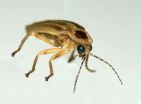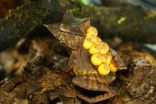(Press-News.org) The nighttime twinkling of fireflies has inspired scientists to modify a light-emitting diode (LED) so it is more than one and a half times as efficient as the original. Researchers from Belgium, France, and Canada studied the internal structure of firefly lanterns, the organs on the bioluminescent insects' abdomens that flash to attract mates. The scientists identified an unexpected pattern of jagged scales that enhanced the lanterns' glow, and applied that knowledge to LED design to create an LED overlayer that mimicked the natural structure. The overlayer, which increased LED light extraction by up to 55 percent, could be easily tailored to existing diode designs to help humans light up the night while using less energy. The work is published in a pair of papers today in the Optical Society's (OSA) open-access journal Optics Express.
"The most important aspect of this work is that it shows how much we can learn by carefully observing nature," says Annick Bay, a Ph.D. student at the University of Namur in Belgium who studies natural photonic structures, including beetle scales and butterfly wings. When her advisor, Jean Pol Vigneron, visited Central America to conduct field work on the Panamanian tortoise beetle (Charidotella egregia), he also noticed clouds of twinkling fireflies and brought some specimens back to the lab to examine in more detail.
Fireflies create light through a chemical reaction that takes place in specialized cells called photocytes. The light is emitted through a part of the insect's exoskeleton called the cuticle. Light travels through the cuticle more slowly than it travels through air, and the mismatch means a proportion of the light is reflected back into the lantern, dimming the glow. The unique surface geometry of some fireflies' cuticles, however, can help minimize internal reflections, meaning more light escapes to reach the eyes of potential firefly suitors.
In Optics Express papers, Bay, Vigneron, and colleagues first describe the intricate structures they saw when they examined firefly lanterns and then present how the same features could enhance LED design. Using scanning electron microscopes, the researchers identified structures such as nanoscale ribs and larger, misfit scales, on the fireflies' cuticles. When the researchers used computer simulations to model how the structures affected light transmission they found that the sharp edges of the jagged, misfit scales let out the most light. The finding was confirmed experimentally when the researchers observed the edges glowing the brightest when the cuticle was illuminated from below.
"We refer to the edge structures as having a factory roof shape," says Bay. "The tips of the scales protrude and have a tilted slope, like a factory roof." The protrusions repeat approximately every 10 micrometers, with a height of approximately 3 micrometers. "In the beginning we thought smaller nanoscale structures would be most important, but surprisingly in the end we found the structure that was the most effective in improving light extraction was this big-scale structure," says Bay.
Human-made light-emitting devices like LEDs face the same internal reflection problems as fireflies' lanterns and Bay and her colleagues thought a factory roof-shaped coating could make LEDs brighter. In the second Optics Express paper published today, which is included in the Energy Express section of the journal, the researchers describe the method they used to create a jagged overlayer on top of a standard gallium nitride LED. Nicolas André, a postdoctoral researcher at the University of Sherbrooke in Canada, deposited a layer of light-sensitive material on top of the LEDs and then exposed sections with a laser to create the triangular factory-roof profile. Since the LEDs were made from a material that slowed light even more than the fireflies' cuticle, the scientists adjusted the dimensions of the protrusions to a height and width of 5 micrometers to maximize the light extraction.
"What's nice about our technique is that it's an easy process and we don't have to create new LEDs," says Bay. "With a few more steps we can coat and laser pattern an existing LED."
Other research groups have studied the photonic structures in firefly lanterns as well, and have even mimicked some of the structures to enhance light extraction in LEDs, but their work focused on nanoscale features. The Belgium-led team is the first to identify micrometer-scale photonic features, which are larger than the wavelength of visible light, but which surprisingly improved light extraction better than the smaller nanoscale features. The factory roof coating that the researchers tested increased light extraction by more than 50 percent, a significantly higher percentage than other biomimicry approaches have achieved to date. The researchers speculate that, with achievable modifications to current manufacturing techniques, it should be possible to apply these novel design enhancements to current LED production within the next few years.
The firefly specimens that served as the inspiration for the effective new LED coating came from the genus Photuris, which is commonly found in Latin America and the United States. Bay says she has also examined the lanterns of a particularly hardy species of firefly found on the Caribbean island of Guadeloupe that did not have the factory roof structure on the outer layer. She notes that she and her colleagues will continue to explore the great diversity of the natural world, searching for new sources of knowledge and inspiration. "The Photuris fireflies are very effective light emitters, but I am quite sure that there are other species that are even more effective," says Bay. "This work is not over."
INFORMATION:
Papers:
"Improved light extraction in the bioluminescent lantern of a Photuris firefly (Lampyridae)," Optics Express, Vol. 21, Issue 1, pp. 764-780 (2013). (link: http://www.opticsinfobase.org/oe/abstract.cfm?uri=oe-21-1-764)
"An optimal light-extracting overlayer, inspired by the lantern of a Photuris firefly, to improve the external efficiency of existing light-emitting diode," Optics Express, Vol. 21 Issue S1, pp. A179-A189 (2013). (link: http://www.opticsinfobase.org/oe/abstract.cfm?uri=oe-21-S1-A179)
EDITOR'S NOTE: Images of the firefly, scales and LED are available to members of the media upon request. Contact Angela Stark, astark@osa.org.
About Optics Express
Optics Express reports on new developments in all fields of optical science and technology every two weeks. The journal provides rapid publication of original, peer-reviewed papers. It is published by the Optical Society and edited by Andrew M. Weiner of Purdue University. Optics Express is an open-access journal and is available at no cost to readers online at www.OpticsInfoBase.org/OE.
About OSA
Uniting more than 180,000 professionals from 175 countries, the Optical Society (OSA) brings together the global optics community through its programs and initiatives. Since 1916 OSA has worked to advance the common interests of the field, providing educational resources to the scientists, engineers and business leaders who work in the field by promoting the science of light and the advanced technologies made possible by optics and photonics. OSA publications, events, technical groups and programs foster optics knowledge and scientific collaboration among all those with an interest in optics and photonics. For more information, visit www.osa.org.
Scientists mimic fireflies to make brighter LEDs
Optics Express papers detail new bio-inspired coating that increases LED efficiency by 55 percent
2013-01-08
ELSE PRESS RELEASES FROM THIS DATE:
Unlike we thought for 100 years: Molds are able to reproduce sexually
2013-01-08
For over 100 years, it was assumed that the penicillin-producing mould fungus Penicillium chrysogenum only reproduced asexually through spores. An international research team led by Prof. Dr. Ulrich Kück and Julia Böhm from the Chair of General and Molecular Botany at the Ruhr-Universität has now shown for the first time that the fungus also has a sexual cycle, i.e. two "genders". Through sexual reproduction of P. chrysogenum, the researchers generated fungal strains with new biotechnologically relevant properties - such as high penicillin production without the contaminating ...
Parasitic worms may help treat diseases associated with obesity
2013-01-08
Athens, Ga. – On the list of undesirable medical conditions, a parasitic worm infection surely ranks fairly high. Although modern pharmaceuticals have made them less of a threat in some areas, these organisms are still a major cause of disease and disability throughout much of the developing world.
But parasites are not all bad, according to new research by a team of scientists now at the University of Georgia, the Harvard School of Public Health, the Université François Rabelais in Tours, France, and the Central South University, Changsha, Hunan, China.
A study ...
PNAS: Shareholder responsibility could spur shift to sustainable energy
2013-01-08
The research carried out at IIASA in collaboration with the Potsdam Institute for Climate Impact Research demonstrates that there is fundamental rigidity, known as lock-in, within the energy economy that favors the use of fossil fuels and nuclear power despite their large environmental and social costs. The researchers identify that this rigidity of the existing energy economy could be considerably reduced by introducing new rules that hold shareholders of companies liable for the damages caused by the companies they own. Allocating the liability between the company and ...
Females tagged in wasp mating game
2013-01-08
The flick of an antenna may be how a male wasp lays claim to his harem, according to new research at Simon Fraser University.
A team of biologists, led by former PhD graduate student Kelly Ablard, found that when a male targeted a female, he would approach from her from the left side, and once in range, uses the tip of his antenna to tap her antenna.
Ablard suggests the act transfers a yet unidentified specimen-specific pheromone onto the female's antenna that marks the female as "out of bounds," or "tagged."
The tagging-pheromone helps a male relocate the females ...
Rice University discovers that graphene oxide soaks up radioactive waste
2013-01-08
Graphene oxide has a remarkable ability to quickly remove radioactive material from contaminated water, researchers at Rice University and Lomonosov Moscow State University have found.
A collaborative effort by the Rice lab of chemist James Tour and the Moscow lab of chemist Stepan Kalmykov determined that microscopic, atom-thick flakes of graphene oxide bind quickly to natural and human-made radionuclides and condense them into solids. The flakes are soluble in liquids and easily produced in bulk.
The experimental results were reported in the Royal Society of Chemistry ...
Genetic matchmaking saves endangered frogs
2013-01-08
What if Noah got it wrong? What if he paired a male and a female animal thinking they were the same species, and then discovered they were not the same and could not produce offspring? As researchers from the Smithsonian's Panama Amphibian Rescue and Conservation Project race to save frogs from a devastating disease by breeding them in captivity, a genetic test averts mating mix-ups.
At the El Valle Amphibian Conservation Center, project scientists breed 11 different species of highland frogs threatened by the chytrid fungus Batrachochytrium dendrobatidis, which has already ...
New American Chemical Society video series: Conversations with Celebrated Scientists
2013-01-08
The American Chemical Society (ACS), the world's largest scientific society, today launched a new video series that will feature noted scientists discussing the status of knowledge in their fields, their own research, and its impacts and potential impacts on society. Chemistry over Coffee: Conversations with Celebrated Scientists is available at www.acs.org/ChemistryOverCoffee.
The launch episode features Chad Mirkin, Ph.D., and Paul Weiss, Ph.D., internationally known leaders in nanotechnology. Mirkin, director of Northwestern University's International Institute for ...
Teens susceptible to hepatitis B infection despite vaccination as infants
2013-01-08
New research reveals that a significant number of adolescents lose their protection from hepatitis B virus (HBV) infection, despite having received a complete vaccination series as infants. Results in the January 2013 issue of Hepatology, a journal published by Wiley on behalf of the American Association for the Study of Liver Diseases, suggest teens with high-risk mothers (those positive for HBeAg) and teens whose immune system fails to remember a previous viral exposure (immunological memory) are behind HBV reinfection.
Infection with HBV is a major global health concern ...
First study of Oregon's Hmong reveals surprising influences on cancer screenings
2013-01-08
CORVALLIS, Ore. – Cervical cancer rates for Hmong women are among the highest in the nation, yet past research has shown that cervical and breast cancer screening rates for this population are low – in part because of the Hmong's strong patriarchal culture.
However, a new study by Oregon State University researchers examining attitudes regarding breast and cervical cancer screening among Oregon's Hmong population shows a much more complicated picture. The study found that Hmong women often make their own health decisions, but in an environment in which screening is not ...
U-M sibling study discovers genetic region linked to control of key blood-clotting protein
2013-01-08
ANN ARBOR—In 2006, the lab of Dr. David Ginsburg at the Life Sciences Institute put a call out for siblings attending the University of Michigan to donate blood for a study of blood-clotting disorders.
The samples were collected over three years and have now enabled the researchers to identify the specific parts of the genome responsible for levels of a key substance for blood clotting. The findings were reported online Dec. 24 in the Proceedings of the National Academy of Sciences.
Von Willebrand disease is the most common hereditary blood-clotting disorder—it's more ...
LAST 30 PRESS RELEASES:
This new understanding of T cell receptors may improve cancer immunotherapies
A new fossil face sheds light on early migrations of ancient human ancestor
A new immunotherapy approach could work for many types of cancer
A new way to diagnose deadly lung infections and save lives
40 percent of MRI signals do not correspond to actual brain activity
How brain-inspired algorithms could drive down AI energy costs
Gum disease may be linked to plaque buildup in arteries, higher risk of major CVD events
Contrails are a major driver of aviation’s climate impact
Structure of dopamine-releasing neurons relates to the type of circuits they form for smell-processing
Reducing social isolation protects the brain in later life
Keeping the heart healthy increases longevity even after cancer
Young adults commonly mix cannabis with nicotine and tobacco
Comprehensive review illuminates tau protein's dual nature in brain health, disease, and emerging psychiatric connections
Book prepares K-12 leaders for the next public health crisis
Storms in the Southern Ocean mitigates global warming
Seals on the move: Research reveals key data for offshore development and international ecology
Sports injuries sustained during your period might be more severe
World's first successful 2 Tbit/s free-space optical communication using small optical terminals mountable on satellites and HAPS
Can intimate relationships affect your heart? New study says ‘yes’
Scalable and healable gradient textiles for multi‑scenario radiative cooling via bicomponent blow spinning
Research shows informed traders never let a good climate crisis go to waste
Intelligent XGBoost framework enhances asphalt pavement skid resistance assessment
Dual-function biomaterials for postoperative osteosarcoma: Tumor suppression and bone regeneration
New framework reveals where transport emissions concentrate in Singapore
NTP-enhanced lattice oxygen activation in Ce-Co catalysts for low-temperature soot combustion
Synergistic interface engineering in Cu-Zn-Ce catalysts for efficient CO2 hydrogenation to methanol
COVID-19 leaves a lasting mark on the human brain
Scientists use ultrasound to soften and treat cancer tumors without damaging healthy tissue
Community swimming program for Black youth boosts skills, sense of belonging, study finds
Specific depressive symptoms in midlife linked to increased dementia risk
[Press-News.org] Scientists mimic fireflies to make brighter LEDsOptics Express papers detail new bio-inspired coating that increases LED efficiency by 55 percent


